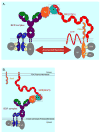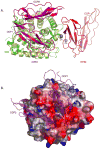Regulation of humoral immunity by complement
- PMID: 22921118
- PMCID: PMC5784422
- DOI: 10.1016/j.immuni.2012.08.002
Regulation of humoral immunity by complement
Abstract
The complement system of innate immunity is important in regulating humoral immunity largely through the complement receptor CR2, which forms a coreceptor on B cells during antigen-induced activation. However, CR2 also retains antigens on follicular dendritic cells (FDCs). Display of antigen on FDCs is critical for clonal selection and affinity maturation of activated B cells. This review will discuss the role of complement in adaptive immunity in general with a focus on the interplay between CR2-associated antigen on B cells with CR2 expressed on FDCs. This latter interaction provides an opportunity for memory B cells to sample antigen over prolonged periods. The cocrystal structure of CR2 with its ligand C3d provides insight into how the complement system regulates access of antigen by B cells with implications for therapeutic manipulations to modulate aberrant B cell responses in the case of autoimmunity.
Copyright © 2012 Elsevier Inc. All rights reserved.
Figures




Similar articles
-
Complement-mediated activation of the adaptive immune responses: role of C3d in linking the innate and adaptive immunity.Immunol Res. 2006;36(1-3):197-210. doi: 10.1385/IR:36:1:197. Immunol Res. 2006. PMID: 17337780 Review.
-
Complement component C3d-antigen complexes can either augment or inhibit B lymphocyte activation and humoral immunity in mice depending on the degree of CD21/CD19 complex engagement.J Immunol. 2005 Dec 15;175(12):8011-23. doi: 10.4049/jimmunol.175.12.8011. J Immunol. 2005. PMID: 16339538
-
Complement receptors CD21 and CD35 in humoral immunity.Immunol Rev. 2007 Oct;219:157-66. doi: 10.1111/j.1600-065X.2007.00556.x. Immunol Rev. 2007. PMID: 17850488 Review.
-
A Novel Image Analysis Approach Reveals a Role for Complement Receptors 1 and 2 in Follicular Dendritic Cell Organization in Germinal Centers.Front Immunol. 2021 Apr 12;12:655753. doi: 10.3389/fimmu.2021.655753. eCollection 2021. Front Immunol. 2021. PMID: 33912182 Free PMC article.
-
Complement receptor type two (CR2,CR21): a target for influencing the humoral immune response and antigen-trapping.Immunol Res. 1999;20(3):187-94. doi: 10.1007/BF02790402. Immunol Res. 1999. PMID: 10741859 Review.
Cited by
-
Complement Cascade Proteins Correlate with Fibrosis and Inflammation in Early-Stage Type 1 Diabetic Kidney Disease in the Ins2Akita Mouse Model.Int J Mol Sci. 2024 Jan 23;25(3):1387. doi: 10.3390/ijms25031387. Int J Mol Sci. 2024. PMID: 38338666 Free PMC article.
-
The complement system in neurodegenerative and inflammatory diseases of the central nervous system.Front Neurol. 2024 Jul 3;15:1396520. doi: 10.3389/fneur.2024.1396520. eCollection 2024. Front Neurol. 2024. PMID: 39022733 Free PMC article. Review.
-
Application of tissue engineering to the immune system: development of artificial lymph nodes.Front Immunol. 2012 Nov 16;3:343. doi: 10.3389/fimmu.2012.00343. eCollection 2012. Front Immunol. 2012. PMID: 23162557 Free PMC article.
-
Protein engineering to target complement evasion in cancer.FEBS Lett. 2014 Jan 21;588(2):334-40. doi: 10.1016/j.febslet.2013.11.007. Epub 2013 Nov 14. FEBS Lett. 2014. PMID: 24239543 Free PMC article. Review.
-
Anaphylatoxins spark the flame in early autoimmunity.Front Immunol. 2022 Jul 25;13:958392. doi: 10.3389/fimmu.2022.958392. eCollection 2022. Front Immunol. 2022. PMID: 35958588 Free PMC article. Review.
References
-
- Barrault DV, Steward M, Cox VF, Smith RA, Knight AM. Efficient production of complement (C3d)3 fusion proteins using the baculovirus expression vector system. J Immunol Methods. 2005;304:158–173. - PubMed
-
- Boes M, Esau C, Fischer MB, Schmidt T, Carroll M, Chen J. Enhanced B-1 cell development, but impaired IgG antibody responses in mice deficient in secreted IgM. J Immunol. 1998;160:4776–4787. - PubMed
-
- Burman JD, Leung E, Atkins KL, O’Seaghdha MN, Lango L, Bernado P, Bagby S, Svergun DI, Foster TJ, Isenman DE, van den Elsen JM. Interaction of human complement with Sbi, a staphylococcal immunoglobulin-binding protein: indications of a novel mechanism of complement evasion by Staphylococcus aureus. J Biol Chem. 2008;283:17579–17593. - PMC - PubMed
Publication types
MeSH terms
Substances
Grants and funding
LinkOut - more resources
Full Text Sources
Other Literature Sources

